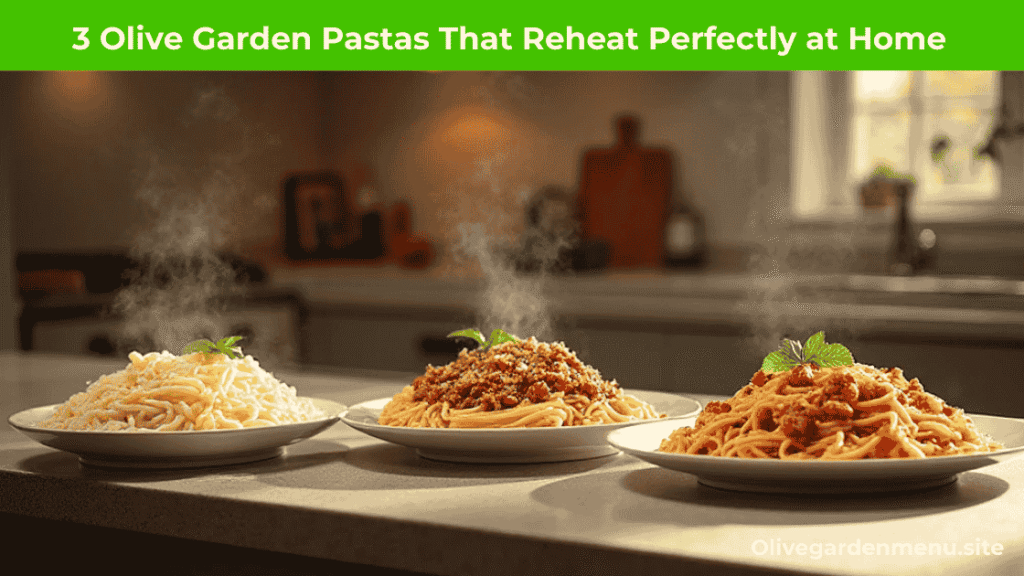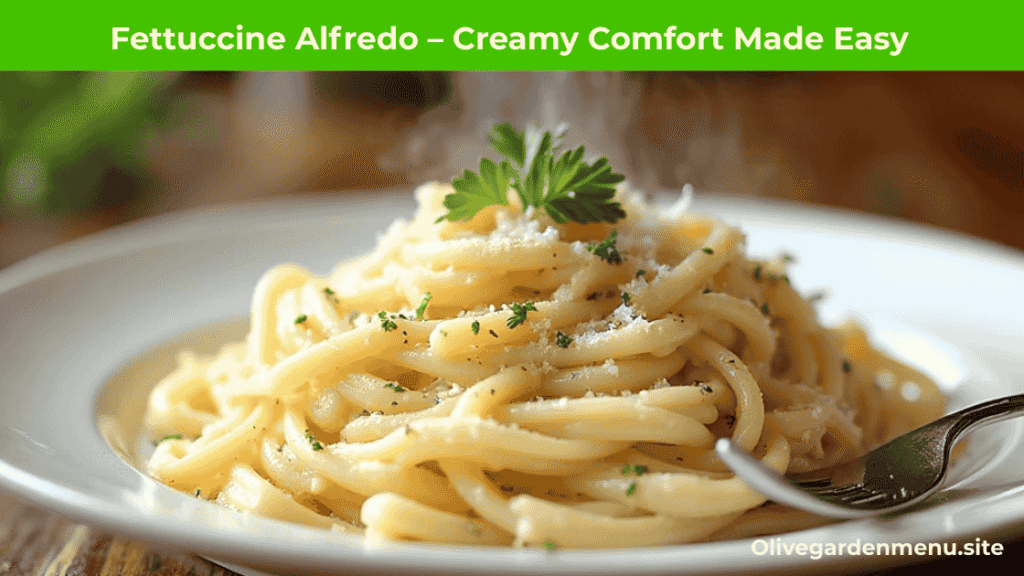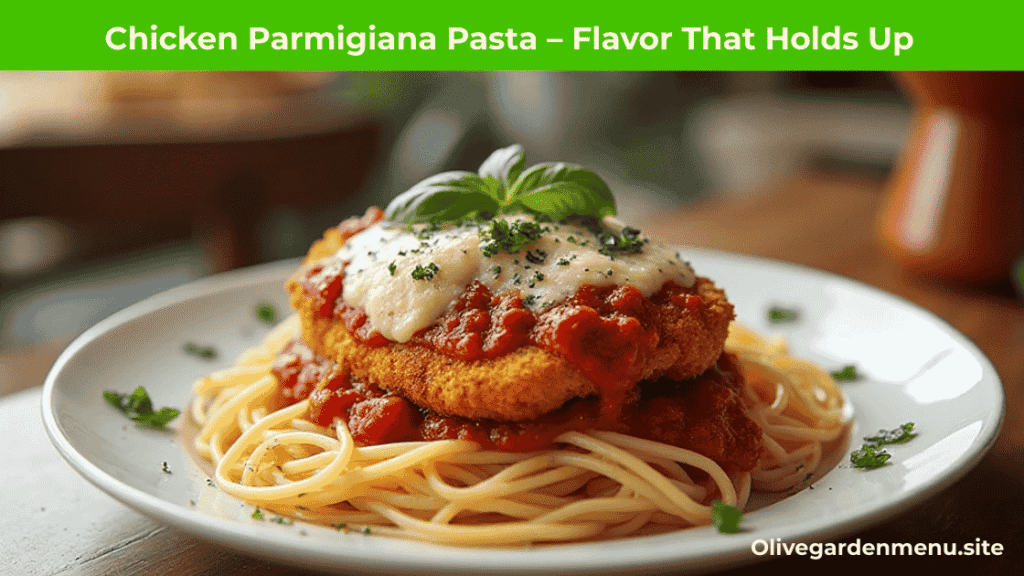There’s something comforting about coming home after a long day and realizing you’ve got a little slice of Olive Garden waiting for you in the fridge. I’ve always been a fan of grabbing extra pasta when I dine out — not because I plan it as leftovers, but because it feels like a little gift to my future self. Over the years, I’ve learned that not every pasta dish travels well from the restaurant to your microwave or stovetop.

Some lose their charm, becoming mushy or separating from the sauce, while others somehow taste just as fresh as when they were first served. Today, I want to walk you through three Olive Garden pastas that reheat beautifully at home, why they hold up so well, and the tricks I’ve picked up to make sure every bite feels like you just ordered it.
Why Some Olive Garden Pastas Reheat Better Than Others
Not all pastas are created equal when it comes to reheating. The secret lies in how the pasta interacts with its sauce, the moisture content, and even the cooking method used at the restaurant. If you’ve ever tried reheating a delicate spaghetti with a light tomato sauce only to find it clumpy and dry, you know exactly what I mean.
Understanding Pasta and Sauce Compatibility
The type of sauce matters just as much as the pasta itself. Cream-based sauces like Alfredo tend to cling to noodles and retain moisture, making them easier to reheat. Heavier baked pastas with cheese also maintain their flavor well because the cheese melts back into the dish, keeping it creamy. On the other hand, thin oil-based sauces can evaporate quickly, leaving pasta dry and unappetizing.
Here’s a quick guide on pasta and sauce compatibility for reheating:
| Pasta Type | Sauce Type | Reheat Success | Notes |
| Fettuccine | Alfredo/Cream | High | Sauce retains moisture, noodles stay tender |
| Ziti | Cheese/Baked | High | Cheese helps maintain texture and flavor |
| Spaghetti | Tomato/Oil | Medium | Can dry out quickly; add water or sauce before reheating |
| Angel Hair | Light Tomato | Low | Extremely delicate, overcooks easily |
Tips to Maintain Texture and Flavor
- Add Moisture: A splash of water, milk, or additional sauce can prevent the pasta from drying out.
- Cover While Heating: Use a microwave-safe lid or aluminum foil on the stovetop to trap steam.
- Gentle Heat: Low and slow is your friend — rapid reheating can make noodles mushy.
- Separate Components: For dishes with crispy toppings like breaded chicken, reheat components separately and combine before serving.
Top 3 Olive Garden Pastas Ideal for Reheating
After plenty of trial and error, I’ve identified three Olive Garden pastas that genuinely shine when reheated. These dishes don’t just survive the fridge — they almost taste like they were freshly made.
Fettuccine Alfredo – Creamy Comfort Made Easy

Fettuccine Alfredo is my go-to leftover pasta. The rich, buttery cream sauce hugs the fettuccine noodles perfectly, and a gentle reheat on the stovetop brings it back to life without losing that silky texture.
Why it works well:
- The creamy sauce prevents noodles from drying out.
- Parmesan cheese melts evenly upon reheating, boosting flavor.
- Simple ingredients mean flavors remain vibrant even after cooling.
Quick Tip: Reheat slowly in a pan over low heat, stirring occasionally. Add a splash of milk if the sauce looks too thick.
Chicken Parmigiana Pasta – Flavor That Holds Up

Chicken Parmigiana Pasta is a powerhouse of flavor. The breaded chicken, tomato sauce, and melted mozzarella work together to maintain texture and taste after being refrigerated.
| Component | Reheat Tip |
| Chicken | Reheat separately in the oven or toaster oven to retain crispiness |
| Pasta & Sauce | Warm gently on the stovetop, add a splash of sauce to prevent drying |
| Cheese | Sprinkle extra mozzarella on top and broil for a few minutes for a fresh melt |
This dish is perfect when you want a hearty, comforting meal that doesn’t compromise on taste after storage.
Five Cheese Ziti al Forno – Cheesy Goodness Every Time

If you’re a cheese lover like me, this baked pasta is a dream for leftovers. The layers of ricotta, mozzarella, Parmesan, Romano, and provolone hold up exceptionally well in the fridge.
Why it’s ideal for reheating:
- Cheese melts back into the pasta, keeping it creamy and flavorful.
- Baked texture softens slightly without becoming soggy.
- Rich flavors develop further, making the second-day taste even more satisfying.
Pro Tip: Cover with foil and bake at 350°F (175°C) for 15–20 minutes, or until heated through. Uncover for the last 5 minutes to get a slightly golden top.
Best Practices for Reheating Olive Garden Pasta at Home
Reheating pasta at home is an art. The right technique can transform leftovers into a restaurant-quality meal, while the wrong one can turn it into a gluey mess.
Stove-Top vs Microwave – Which Method Works Best
- Stove-Top: Best for creamy or baked dishes. Allows you to control temperature and moisture.
- Microwave: Quick and convenient. Works well if you add a little liquid and cover the dish.
| Method | Best For | Tips |
| Stove-Top | Alfredo, Chicken Parmigiana | Low heat, stir frequently, add milk or sauce as needed |
| Oven | Baked Ziti, Lasagna | Cover with foil, bake at 350°F, uncover last 5–10 minutes for golden cheese |
| Microwave | Quick meals, single servings | Add 1–2 tbsp water or sauce, cover, heat in short intervals and stir |
How to Avoid Overcooking or Drying Out
- Low & Slow: Heat gently to prevent noodles from breaking down.
- Add Moisture: A small splash of water, cream, or sauce keeps pasta tender.
- Stir Frequently: Ensures even heat distribution and prevents hot spots.
- Separate Components: If your pasta has meat or crispy toppings, heat separately and combine at the end.
Conclusion
Reheating Olive Garden pastas doesn’t have to feel like a compromise. With a few tips and the right dishes, you can enjoy restaurant-quality flavors right from your kitchen. Fettuccine Alfredo, Chicken Parmigiana Pasta, and Five Cheese Ziti al Forno stand out as my top picks — each retaining its taste, texture, and charm even after being stored in the fridge. By understanding sauce compatibility, adding moisture, and choosing the right heating method, your leftover pasta can be just as satisfying as the first bite. Next time you take home extra pasta, know that the best is yet to come — your fridge holds a second helping of comfort and flavor.
FAQs
Can all Olive Garden pastas be reheated successfully?
Not all pastas reheat well. Cream-based and baked dishes tend to perform best, while delicate, oil-based, or very thin noodles may dry out.
How long should I store leftover Olive Garden pasta?
For optimal flavor and safety, store leftovers in an airtight container in the refrigerator for up to 3–4 days.
Is it better to reheat pasta with or without sauce?
It’s usually better to reheat pasta with its sauce to prevent drying out. If the sauce has separated, stir in a small splash of milk or water.
Can I freeze Olive Garden pasta for later use?
Yes, baked or cream-based pastas freeze well. Store in a freezer-safe container for up to 2 months. Reheat gently in the oven or stovetop.
How do I maintain creamy texture when reheating Alfredo sauces?
Add a little milk or cream during reheating and stir gently over low heat. Avoid boiling, as high heat can cause the sauce to separate.
